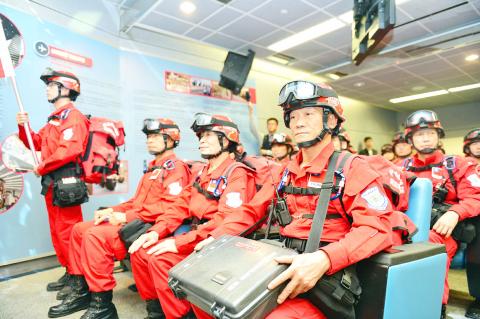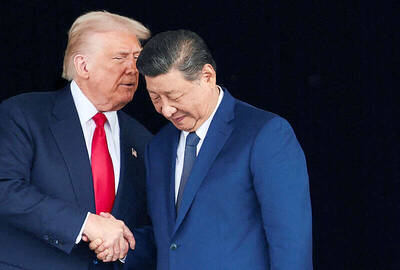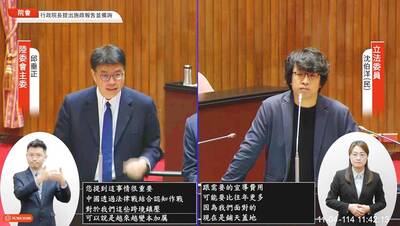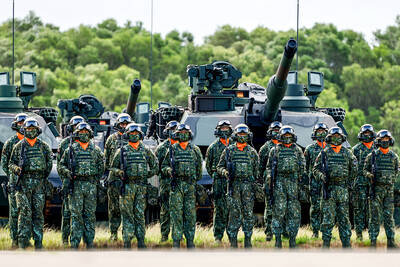Dozens of Taiwanese disaster relief and healthcare workers, representatives of charity groups and a medical team led by government officials yesterday left for Nepal, but Taiwan is still waiting for permits from Kathmandu to send search-and-rescue teams, authorities said.
A 37-member team from the Buddha’s Light International Association and physicians and nurses from Kaohsiung Chang Gung Memorial Hospital left in the morning, taking 5 tonnes of relief supplies, including blankets, tents, dried foods and medical supplies.
The team is scheduled to stay in Nepal for five days, International Headquarters Search and Rescue head Lu Cheng-tsung (呂正宗) said.

Photo: Yao Kai-shiou Taipei Times
Six medical personnel from the government-sponsored Taiwan International Health Action led by a Ministry of Health and Welfare official and accompanied by two Ministry of Foreign Affairs officials familiar with the situation in Nepal left in the afternoon.
Representative to India James Tien (田中光), who has been in Kathmandu since the earthquake on Saturday, would assist the relief workers if needed, foreign ministry spokesperson Anna Kao (高安) said.
Kathmandu has not yet accepted Taiwan’s offer to send official search-and-rescue teams.
Deputy Minister of Foreign Affairs Andrew Kao (高振群) on Monday said that Kathmandu has asked for search-and-rescue help only from neighbors such as China, India and Pakistan, and cited the great distance and the lack of direct flights and diplomatic relations for the handling of Taiwan’s offer.
Early yesterday at a regular news conference, Ministry of National Defense spokesperson David Lo (羅紹和) said the ministry has had everything ready to dispatch C-130 aircraft from Pingtung County to Nepal.
However, anonymous sources at the defense ministry said it would be more efficient to deliver aid via commercial flights than military aircraft because it would take the C-130s 11 to 14 hours to reach Nepal as they would have to fly over open ocean instead of crossing China’s airspace, the sources said.
The lack of diplomatic relations with most nations in the region would also create problems if they were to allow the aircraft through their airspace or grant them necessary refueling stops en route to Nepal, the sources added.

CALL FOR SUPPORT: President William Lai called on lawmakers across party lines to ensure the livelihood of Taiwanese and that national security is protected President William Lai (賴清德) yesterday called for bipartisan support for Taiwan’s investment in self-defense capabilities at the christening and launch of two coast guard vessels at CSBC Corp, Taiwan’s (台灣國際造船) shipyard in Kaohsiung. The Taipei (台北) is the fourth and final ship of the Chiayi-class offshore patrol vessels, and the Siraya (西拉雅) is the Coast Guard Administration’s (CGA) first-ever ocean patrol vessel, the government said. The Taipei is the fourth and final ship of the Chiayi-class offshore patrol vessels with a displacement of about 4,000 tonnes, Lai said. This ship class was ordered as a result of former president Tsai Ing-wen’s (蔡英文) 2018

‘SECRETS’: While saying China would not attack during his presidency, Donald Trump declined to say how Washington would respond if Beijing were to take military action US President Donald Trump said that China would not take military action against Taiwan while he is president, as the Chinese leaders “know the consequences.” Trump made the statement during an interview on CBS’ 60 Minutes program that aired on Sunday, a few days after his meeting with Chinese President Xi Jinping (習近平) in South Korea. “He [Xi] has openly said, and his people have openly said at meetings, ‘we would never do anything while President Trump is president,’ because they know the consequences,” Trump said in the interview. However, he repeatedly declined to say exactly how Washington would respond in

WARFARE: All sectors of society should recognize, unite, and collectively resist and condemn Beijing’s cross-border suppression, MAC Minister Chiu Chui-cheng said The number of Taiwanese detained because of legal affairs by Chinese authorities has tripled this year, as Beijing intensified its intimidation and division of Taiwanese by combining lawfare and cognitive warfare, the Mainland Affairs Council (MAC) said yesterday. MAC Minister Chiu Chui-cheng (邱垂正) made the statement in response to questions by Democratic Progressive Party (DPP) Legislator Puma Shen (沈柏洋) about the government’s response to counter Chinese public opinion warfare, lawfare and psychological warfare. Shen said he is also being investigated by China for promoting “Taiwanese independence.” He was referring to a report published on Tuesday last week by China’s state-run Xinhua news agency,

‘NOT SUBORDINATE’: Only Taiwanese can decide the nation’s future, and people preserving their democratic way of life is not a provocation, President William Lai said Taiwan does not want China’s “one country, two systems,” and must uphold its freedom and democracy as well as resolve to defend itself, President William Lai (賴清德) said yesterday, rejecting Beijing’s latest bid to bring the country under Chinese control. The president made the remarks while attending a commissioning ceremony for Taiwan’s first battalion of M1A2T Abrams tanks in Hsinchu County’s Hukou Township (湖口). The tanks are made by General Dynamics, a major US defense contractor. China this week said it “absolutely will not” rule out using force over Taiwan, striking a much tougher tone than a series of articles in state media